
Exclusive Preview from Scott Bowden's new book: Napoleon and Austerlitz
 Editor's Note: In the summer of 1805, England was once again at war with France. The government in London was able to form a Third Coalition with Austria and Russia. Their mutual goal was to defeat the newly self-appointed Emperor of the French, depose Napoleon in favor of the Bourbon monarchy, and restore the boundaries of Europe to those of pre-Revolutionary France.
Editor's Note: In the summer of 1805, England was once again at war with France. The government in London was able to form a Third Coalition with Austria and Russia. Their mutual goal was to defeat the newly self-appointed Emperor of the French, depose Napoleon in favor of the Bourbon monarchy, and restore the boundaries of Europe to those of pre-Revolutionary France.
At left, French soldier from the 4th Legere regiment wears the new shako and uniform of the Grande Armee, 1805. © Keith Rocco
The Allied grand strategy called for Italy to be the main theater of the war, while along the Danube an Austrian army under Archduke Ferdinand (but actually under de facto command of General Karl Freiherr Mack von Leiberich) waited to be reinforced by approaching Russian forces. Mack told the court in Vienna that his army should not wait but move with the utmost speed to the Iller River and city of Ulm, which Mack described as "the queen of the Danube and the Iller, the bulwark of the Tyrol, and the key to half of Germany." The city of Ulm had proved important during nearly every campaign for Germany since the era of Gustavus Adolphus in the first half of the 1600s; almost two hundred years later, it would be the focul point for the first campaign by the Grande Armee -- Napoleon's new name for his reorganized and highly trained army.
Mack received permission to move away from his approaching allies and marched rapidly across Bavaria, arriving at the juncture of the Iller and Danube Rivers in early September, then faced his forces west to meet the expected French advance.
Napoleon had meanwhile marched his corps at an even quicker pace from the English Channel, across France and the Low Countries, and crossed the Danube behind Mack's army to the east of Ulm, severing the Austrian line of communications with Vienna. Although taken by surprise, the Austrian commander was convinced that the strength of his position around Ulm was so formidable that he could easily hold out until the Russian army under General Kutuzov arrived. Then, Mack reasoned, his army at Ulm would be "the anvil against which the Russian hammer" would destroy the French.
Things did not go as planned for the unfortunate Mack. Minor actions on 8 and 9 October had forced his reconnaissance probes back to Ulm, and he began to realize how strong the French forces were between his army and Vienna. Then, on 11 October, an opportunity appeared. On the north side of the Danube, an apparently isolated French division appeared opposite Mack's fortified position at Ulm. Without hesitation, Mack threw nearly 23,000 infantry and cavalry against the 5,000 Frenchmen. What happened next at the battle of Haslach-Jungingen is presented here in an exclusive preview from Scott Bowden's new book to be released in 1997: Napoleon and Austerlitz, the first in a three volume series presenting in unprecedented detail the campaigns of 1805, 1806, and 1807, collectively called "The Glory Years" for Napoleon's Grande Armee
As Marmont and the other Napoleonic troops were closing fast on Ulm and the southern side of the Danube, remarkable developments were underway on the northern bank. When Napoleon gave authorization to his brother-in-law, Marshal Murat, to coordinate the movements of not only his own cavalry reserve, but also the 5th and 6th Corps, the Emperor did so under the assumption that Mack would not remain at Ulm.
"I am writing to Prince Murat," the Emperor informed Marshal Lannes on 17 vendemiaire (9 October), "to give him authority over your body of troops. If new circumstances do not change anything, you will soon be in a position to be near Augsburg by sometime tomorrow in order to complete operations that are judged to be necessary."
The operation that the Emperor was referring to was the anticipated movement of Mack either east towards Ausgburg or south to the Tyrol to escape the Grande Armee. This opinion was conveyed to Murat, who saw no need for Ney to maintain any of his troops on the north bank of the Danube. Following the victory at Gunzburg, the reinforced 6th Corps had approximately 15,000 men still remaining on the north bank. These were composed of the 1st Infantry Division under General Dupont, the 1st Hussars of Colbert's 6th Corps light cavalry, plus General Bourcier's 4th Dragoon Division and General Baraguay d'Hilliers Dismounted Dragoon Division. The remainder of Ney's command--two regiments of Colbert's light cavalry, plus the 2nd and 3rd Infantry Divisions under Loison and Malher, respectively--were on the southern bank. Murat therefore ordered Ney to bring all of his command except the attached dragoon division to the south bank so that all divisions could participate in the anticipated action on the south side of the Danube. Bourcier's horsemen would cover the north bank.
Ney had a different opinion. Prisoners taken at Gunzburg confirmed three things: 1) Austrian morale was plumeting; 2) the dispirited troops were retreating towards Biberach and Ulm; and 3) a portion of Mack's army was still at Ulm, which meant that the Austrians were already on the north bank of the Danube. The commander of the artillery of 6th Corps, general de brigade Seroux, remembered Marshal Ney asking his staff: "Why don't the Austrians seize the opportunity to escape by the left [north] bank of the Danube, trampling under their feet all our baggage and artillery, which certainly cannot give them much opposition?" The redheaded Marshal therefore believed that his entire corps was needed on the north bank in order to prevent the Austrians from escaping towards the northeast.
This seemingly reasonable request fell on deaf ears. Murat would hear none of these arguments. The Emperor had expressed the opinion that the Austrians would be abandoning Ulm in order to flee southward. Armed with this Imperial insight, Murat was unswerving in his belief that Napoleon knew best. Numerous exchanges flew between the marshals. Verbal requests by Ney to move his entire corps to the north bank were countered with verbal instructions from Murat to do the exact opposite. This bickering went on for hours, consuming most of the daylight hours of 10 October.
Finally, Murat had had enough. He sent written instructions to Ney which made it impossible to change the positions of the divisions of 6th Corps. "It remains understood," Murat wrote Ney at 6:00 P.M. on 18 vendemiaire (10 October), "to take Ulm and the important surrounding points. His Majesty gives you a free hand to achieve this goal during tomorrow morning [11 October]. The Dismounted Dragoon Division will accompany you...." A quick-tempered Ney took this imperious response personally. He considered that the inexperienced Murat had no business speaking for the Emperor.
Mounting his horse, Ney decided to ride to Murat's headquarters to settle the matter. Along the way, Ney met up with Lannes. In Lannes entourage was chef d'escadron Subervie, who remembered that Ney was livid:
"It is a ridiculous order, " Ney declared to Lannes. "If the Austrians come out that way, Bourcier cannot stop them. And once they get through, they can turn and roll up every supply wagon and ammunition cart in the whole army. Then we will be cut off from France. I cannot understand what Murat means."
"The trouble with Murat," Lannes responded, "is that he cannot see anything on a grand scale. He's an able cavalry leader in battle, but he's no grand-tactician, and the Emperor ought to know it."
"It's too much of a family affair," Ney concluded. "Even though Murat is his brother-in-law, there is no reason why the Emperor should intrust him with so much authority. If he does not stop listening so much to his damned sisters, they will ruin him."
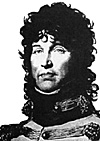 At right, Marshal Joachim Murat. Two days before Haslach-Jungingen, napoleon gave him temporary command authority over three corps, including Marshal Ney's 6th Corps. Completely out of his depth as an army wing commander, Murat refused to allow Ney the latitude to reinforce DuPont's division on the north bank of the Danube.
At right, Marshal Joachim Murat. Two days before Haslach-Jungingen, napoleon gave him temporary command authority over three corps, including Marshal Ney's 6th Corps. Completely out of his depth as an army wing commander, Murat refused to allow Ney the latitude to reinforce DuPont's division on the north bank of the Danube.
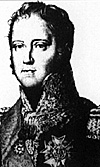 At right, marshal Michel Ney, commander 6th Corps Grande Armee. Often maligned for his errors, Ney correctly foresaw the danger that awaited DuPont at Haslach-Jungingen. He attempted to convince Murat to authorize reinforcements to be sent from the south bank to the north bank in the event the Austrians sortied from Ulm.
At right, marshal Michel Ney, commander 6th Corps Grande Armee. Often maligned for his errors, Ney correctly foresaw the danger that awaited DuPont at Haslach-Jungingen. He attempted to convince Murat to authorize reinforcements to be sent from the south bank to the north bank in the event the Austrians sortied from Ulm.
"You are making a mistake, Murat,
but today you are in command.
Your orders will be obeyed.
Arriving at Murat's headquarters, Ney argued his case. General Belliard, Murat's chief-of-staff, remembered Ney spreading a map over a table and attempting to point out the dangers of Murat's proposed order. Heated words flew between the two marshals until the tension grew to break point as Murat pointedly told Ney: "You understood nothing of the plans of the army."
Furthermore, Murat haughtily added that: "It is my way to make my plans in the face of the enemy!" Ney put his hand to his sword hilt. The two might have settled the matter right then and there had it not been for the intervention of other officers. Finally resigning himself to the situation, Ney chose to defuse the matter and concluded the confrontation with these words. "You are making a mistake, Murat, but today you are in command. Your orders will be obeyed." With that, Ney turned and departed.
The significance of this disagreement was that the position of Ney's command remained unchanged during 10-11 October. Rather than Loison, Malher and Colbert recrossing the Danube and uniting with Dupont and the others on the north bank as Ney originally requested, Dupont and Baraguay d'Hilliers continued to follow the orders given to them on the day before. Ney wrote Dupont early on 18 vendemiaire (10 October):
"The enemy is gripped by an unprecedented fear. They appear to be retreating towards Biberach, to save themselves by moving into the Tyrol . . . It is probable that Archduke Ferdinand remains at Ulm with only a weak force in order to act as a rear guard. However, if this is not the case, our preparations and threatening movements will force the enemy commander to emerge from Ulm if he dares to fight."
It was the possibility of this latter scenario that made Ney think it wise to unite his corps on the north bank of the Danube. However, because of Murat's directive, no such orders were issued. Instead, Dupont and Baraguay remained on the north bank and were to advance on Ulm without delay. These divisions were supported by General Sahuc's brigade of dragoons from Bourcier's 4th Dragoon Division.
While some historians have either wondered why Ney left Dupont on the north side of the Danube, or outright blamed the redhead for Dupont's isolated positioning, it is clear why that Marshal's troops did not receive new orders for 11 October. Even though Ney told Dupont on the 10th that he believed that the enemy was already on the run towards Biberach, the Marshal also was clearly aware of the possibility that the Austrians around Ulm could sortie against his troops on the north bank. It was for that reason that Ney argued to bring the entire 6th Corps onto the north side of the Danube.
Murat, at least during the early hours of 10 October, insisted that all troops come over to the south bank. However, owing to the day slipping away by dealing with Ney's continuing objections, Murat sent his written instructions to the commander of 6th Corps that prevented any changes in dispositions. As a result, Dupont marched on 11 October under the same orders he had received the day before because the friction between the two marshals had created a temporary command paralysis. Therefore, with the Danube dividing the divisions of the 6th Corps, Ney's troops kept their relative positions as they resumed their march towards Ulm.
Ulm
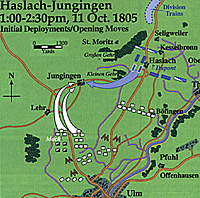 Located on the north bank of the Danube, the fortified place of Ulm was indeed an impressive position. The city was next to the river, with a secession of terraced heights rising up from it towards the northwest. The highest elevation was called the Michelsberg plateau, and it was on those heights and the neighboring Frauenberg plateau that Mack's army was entrenched (for the sake of simplicity, the term "Michelsberg" is intended to include both the Michelsberg and Frauenberg plateaus). Three main roads and one minor one led from Ulm to other points on the north bank. Along the Danube, one major road led south while a minor road followed the river north. Two major roads ascended the Michelsberg heights to lead northwest and north from the city. Alongside each of these roads, the Austrians constructed two redoubts from which their heavy artillery could control the ground. From this dominating terrain, the Austrians could see the surrounding countryside in all directions as the Michelsberg heights dominated not only the marshy plain that comprised the south bank of the Danube, but also the immediately adjoining ground on the north bank.
Located on the north bank of the Danube, the fortified place of Ulm was indeed an impressive position. The city was next to the river, with a secession of terraced heights rising up from it towards the northwest. The highest elevation was called the Michelsberg plateau, and it was on those heights and the neighboring Frauenberg plateau that Mack's army was entrenched (for the sake of simplicity, the term "Michelsberg" is intended to include both the Michelsberg and Frauenberg plateaus). Three main roads and one minor one led from Ulm to other points on the north bank. Along the Danube, one major road led south while a minor road followed the river north. Two major roads ascended the Michelsberg heights to lead northwest and north from the city. Alongside each of these roads, the Austrians constructed two redoubts from which their heavy artillery could control the ground. From this dominating terrain, the Austrians could see the surrounding countryside in all directions as the Michelsberg heights dominated not only the marshy plain that comprised the south bank of the Danube, but also the immediately adjoining ground on the north bank.
It was on this north bank terrain that elements of Ney's 6th Corps, reinforced by some dragoons of Murat's Corps de Reserve de Cavalerie, suddenly appeared at the village of Haslach some two miles in front of the Austrian encampment on the Michelsberg. Marching south along the road from Albeck were General Dupont and the 1st Infantry Division of 6th Corps, along with Colonel Rouvillois' 1st Hussars and the 15th and 17th Dragoons of General Sahuc's brigade from the 4th Dragoon Division. The maneuvers over the past several days, during which the rain and snow had fallen almost nonstop, had reduced the number of hardy souls that remained in Dupont's command.
When the 1st Division crossed the Rhine on 26 September, the three infantry regiments that comprised the division totaled 5,146 combatants present and under arms. When Dupont's infantry formed ranks 15 days later, they numbered 4,105 officers and other ranks--a rate of strategic consumption of just over 20%. Supporting these fantassins were artillerists and eight pieces of ordnance. Two 8-pounder guns were manned by a 39-man detachment of horse artillerists, while two 4-pounder cannon and four 6-inch howitzers formed a six-piece battery served by a full company of foot artillerists that numbered 89 persons. All these artillerists were further supported by 59 personnel of the train of artillery and four ouvriers.
Attached to Dupont were three regiments of cavalry. The 1st Hussars were from the 6th Corps Cavalry Brigade, and consisted of three squadrons. When these cavalrymen crossed the Rhine, they numbered 375 officers and other ranks. On 11 October, the numbers of the 1st Hussars had increased to 383, thanks to reinforcements received just days before. The other cavalry regiments marching with Dupont were the 15th and 17th Dragoons totaling some 600 combatants. Therefore, excluding general officers and their staffs, the French force that fought at Haslach-Jungingen numbered 5,275 officers and other ranks, of which 4,105 were infantry, 983 were cavalry, plus 187 artillerists and other support personnel serving eight pieces of ordnance.
The leader of these forces was General Pierre Dupont de l'Étang, the commander of Ney's 1st Infantry Division. In 1805, Dupont was considered by many to be one of the army's rising stars. The son of General Pierre-Antoine Dupont-Chaumont, Dupont entered military service in 1784 at the age of 19 as a sous-lieutenant with the legion de Maillebois in the service of Holland. During the early years of the Revolution, the young Dupont was invariably with the same regiment, or attached to the same headquarters, as his father. He served at the Battles of Tourcoing and Werwicq in 1793.
At right, General Pierre Dupont de l'Etang. The 40-year old Dupont was a highly regarded officer who commanded the 1st infantry division of Ney's 6th Corp.
On Christmas Day of that same year, Dupont with 15,000 men defeated 45,000 Austrians at the Battle of Pozzolo. He was transferred the following year and joined Ney's command in August 1803. Four months later, on 12 December 1803, Dupont was placed in command of the 1st Infantry Division at the camp of Montreuil. Therefore, as Dupont led forward his troops at Haslach-Jungingen, he did so with the confidence of a career soldier who, in 20 years of service, had never tasted defeat.
When Dupont saw the Michelsberg plateau at 1:00 P.M. on 11 October, he was expecting a possible confrontation with the rearguard of the Austrian army. Instead of only a few enemy regiments awaiting the French advance, vedettes of the 1st Hussars reported that the enemy was present in great strength. Dupont decided to take a closer look for himself. Riding south along the Ulm-Heidenheim Road that connects Albeck to Ulm, Dupont got an eye full. There on the heights above the city was what must have seemed to Dupont to be Mack's entire host. Although many of Mack's soldiers were not on the Michelsberg but rather deployed on the south bank below Ulm, what the French general did see was well over 20,000 of the enemy, including several regiments of Austrian cavalry.
The sudden appearance of Dupont's command stirred the indolent Austrian cavalry patrols, who took word back to Mack that the army had some unexpected visitors. It was only earlier that morning when General Mack received Colonel Bianchi of Archduke Ferdinand's staff along with General Gyulai. Bianchi had just come from an inspection of the entrenchments on the Michelsberg, and expressed his concern that if the army was to hold these positions, the works would have to be significantly strengthened.
Although Mack dismissed the talk, stating that the French would not dare attack such a strong position, the Austrian general once again changed his mind as to what course the army should follow. By reversing himself from the decision made two days earlier to march forthwith from Ulm along the north bank of the Danube and into Bohemia, Mack once again fell under the spell of Ulm. It was a trance that had long mesmerized the Habsburg noble. The entrenched camp of Ulm, Mack believed, was "the anvil against which the Russian hammer" would destroy Napoleon. Mack told Bianchi and the other officers: "It rains; it snows; the enemy sticks quietly in his camp and we will do the same. We will remain in Ulm, where we are safe."
Despite the aura of disaster all around him, Mack remained convinced of the invincibility of the position of Ulm. The general ordered all foodstuffs from the surrounding countryside to be brought into the fortified camp. With the countryside stripped of subsistence, Mack reasoned that the French would be severely handicapped when they arrived in front of Ulm. What's more, Mack's statement to Bianchi strongly suggests that he assumed that the French would not be moving in bad weather--another indication that Mack was fighting an 18th Century style of war against a new, modern army.
However, Mack's attitude abruptly changed after Dupont made his appearance on the Ulm-Heidenheim Road, prompting an Austrian call to arms. While the whitecoated infantry quickly formed ranks as the Austrian cavalry mounted and moved towards the French, Dupont had to make a quick decision. He could either immediately order a withdrawal, or he could stay and fight.
If he gave the order to withdraw, Dupont reasoned that such a course would be tantamount to announcing to the Austrians that he was an isolated detachment. If he acted in this manner, Dupont believed that he would encourage his foe to act more aggressively--a most dangerous possiblity considering that the Austrians had an overwhelming numerical superiority. Alternatively, Dupont could deploy his division for battle, hoping that such boldness would cause the Austrians to consider that he might be the advance guard of an entire corps and therefore move against him with caution. With a sense of Gallic elan and audacity, Dupont chose the bolder course of action.
This article appears in MagWeb (Magazine Web) on the Internet World Wide Web.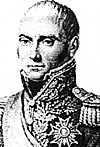 In 1795, at age 30, Dupont was promoted to general de brigade. Two years later, Dupont received his advancement in rank to general de division. During those years, Dupont served in various administrative capacities until being named as chief of staff to Berthier in 1800. Seeing action at Fort Bard and at Marengo, Dupont negotiated the convention of Alexandria, after which he was promoted on 28 August 1800 to the command of the right wing of the Armee d'Italie.
In 1795, at age 30, Dupont was promoted to general de brigade. Two years later, Dupont received his advancement in rank to general de division. During those years, Dupont served in various administrative capacities until being named as chief of staff to Berthier in 1800. Seeing action at Fort Bard and at Marengo, Dupont negotiated the convention of Alexandria, after which he was promoted on 28 August 1800 to the command of the right wing of the Armee d'Italie.
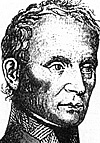 At left, Mack, commander of the Austrian Army of Swabia.
At left, Mack, commander of the Austrian Army of Swabia.
Back to Table of Contents -- Napoleon #5
© Copyright 1996 by Emperor's Press.
The full text and graphics from other military history magazines and gaming magazines are available at http://www.magweb.com